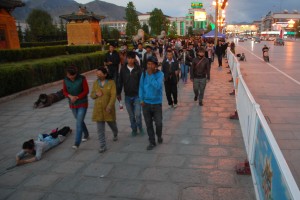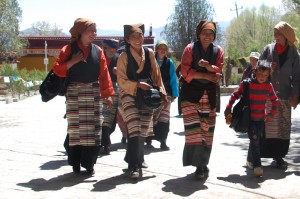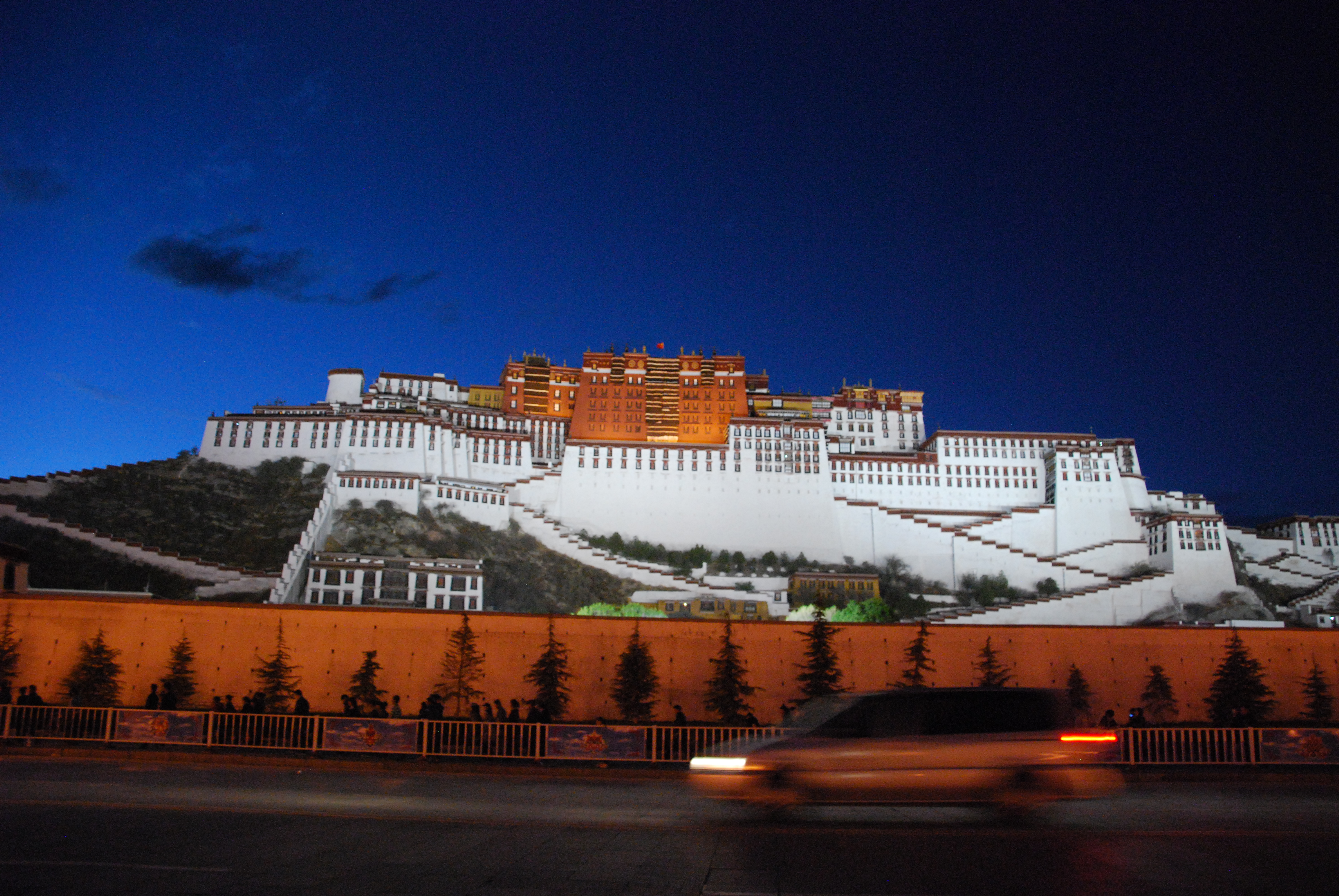Lotsa Lhasa
Lhasa has an unmatchable mix of culture, history, politics and religion, mixing them all together in a complex and beautiful package for any intrepid traveller who is prepared to negotiate the maze of visas, permits, costs and distance in order to get there. We spent two more fabulous days exploring every nook and cranny, trying to get the best possible understanding of the place. The whole experience was overwhelming!
We started off at nearby Jokhang Temple, only a short walk from our old hotel and right in the middle of Old Lhasa. Originally built in the 7th century, upgraded and repaired many times, seriously damaged during the Cultural Revolution which saw the Chinese destroy thousands of Tibetan religious sites, rebuilt in the 1980’s, Jokhang Temple is the most important site for Buddhists in Tibet. A steady stream of pilgrims follow the kora, or pilgrim’s path, around the structure which adds a fantastic colourful and traditional feel to the city.
The temple is largely accessible to visitors and we were able to wander through most of its chambers and chapels as Kelsang gave us the right amount of information about its history and significance. Unlike temples in Thailand, here they burn Juniper tree branches which emit a strong fragrance and white smoke and they also burn thousands of yak butter candles. So the temple was full of people, smoke and incense as well as hundreds of Buddha, saints and other religious figures.
Pilgrims line up outside for hours, slowly making their way in to pay homage to hundreds of religious images. Tourists just need to pay their entrance fee and then shove their way right through the gate and have virtual free rein. But the thing that made Jokhang Temple really special was its obvious significance to the people of Tibet – it is a living, breathing critical part of their lives and a quite a spiritual moment for us to experience with them.

Locals crowd around a display of this 'caterpillar fungus' which allegedly has amazing medicinal values
Kelsang took us on a little walking tour of some of the market area, explaining many of the unusual foods and styles of dress. We saw large trays of the strange ‘caterpillar fungus’ which is harvested in the hills this time of year and is quite expensive due to its traditional medicinal value. We had a lunch in a traditional Tibetan home, complete with local tea and the usual pile of rice and potatoes. We then jumped in our car and drove the short way out of town to the Sera Monastery, perched up on a hill surrounded by snow-capped mountains and brilliant blue skies.
Sera Monastery was built in the 15th century and at one time its sprawling compound housed and educated 5,000 monks, the second largest in Tibet. Today it has only about 250 monks but there are beautiful walks around its grounds, through some of its residences, into a couple of the elaborately decorated temples (one of which had a long line of locals waiting to get their children blessed by a horse-headed protector….).
But the key attraction of the Sera Monastery these days is to watch the monks’ debating session. Most of the resident monks would attend, some sitting down in the shade of the trees while others stand in front and vocally put forward their philosophical position on points in the Buddhist scriptures. This was done loudly with a lot of body and hand movement, many points accentuated by the loud clapping of hands. It was a surreal moment, almost Pythonesque, watching monks vocally and almost physically debate ancient points of their beliefs.

Pilgrims doing their kora around Potala Palace at night, including those who prostate themselves all the way
The late afternoon was spent in the open air markets – where else? – followed by drinks and dinner. We then walked down into the newer sections of Lhasa with modern shops and a large mall under construction until we were at the foot of the magnificent Potala Palace. We got there just at dusk and watched as it got darker and the lights on the Palace brought it to life, sitting over 100 metres up on the hill. The Potala Palace is truly one of the gems of the world, a magnificent structure in all manners and revered by the locals who streamed around it in their kora, or pilgrimage, in the thousands.

Pilgrims performing their kora, or walk around the Potala Palace - its a religious and sociable event
Over lunch today our guide Kelsang told us a few interesting facts about her life. She is 27 and from western Tibet, the eighth of nine children (large families were previously common in Tibet) but she had the good fortune of studying in India for ten years, only returning to Lhasa a few years ago. But because of this overseas education and upbringing she does not speak or read Chinese well which must be a challenge because Chinese is used throughout all the schools and is the official national language.
Of her eight siblings, three of her brothers are married to the one girl in an arranged marriage. Yes, this is the opposite of polygamy and is called polygyny, not uncommon in Bhutan and apparently Tibet. This polygyny marriage took place quite recently and Kelsang spoke openly about it. The reason for this arrangement is that in this way the family plot of land does not have to be divided up into blocks that are too small to support a family. So the three brothers work the fields by day and who knows what happens at night.
The elevation of Lhasa, about 3,650 metres, has certainly impacted our energy, drinking and eating levels. The thin air makes it hard to breathe and easy to tire but its a small price to pay for another great day.
Tibet is basically a police state of China. Policemen and military types stand on most corners, often checking IDs and just harassing the locals. We saw numerous examples of this over the three days in Lhasa. Our driver, who admittedly was stretching the very pliable Tibet driving rules a bit too far, was pulled over and fined on the spot a whopping 200 Yuan (about $32), which of course went straight into the bottom of the policeman’s pocket.
But we constantly have to go through security checks, some of them more intensive than at an international airport, even including pat downs, passport checks and throwing out water bottles. It is both arbitrary and systematic but even if they don’t stop you they are watching you. And they position themselves in the temples, sometimes stupidly dressed in bright orange overalls as if they are maintenance crews, watching the people worship, standing close to us and listening to our conversations, just ridiculous. This obviously is not the path toward winning the heart of the locals.
The last day in Lhasa was full on if you like palaces and temples….which we do but….we were being tested. In the morning we visited the Norbulingka Palace which has been the summer palaces of all Dalai Lamas since the 18th century. It is actually a large cluster of buildings set in a sprawling (and poorly maintained) garden with each building serving a different function.
Norbulingka is the place where the current (14th) Dalai Lama made his escape from Tibet in 1959 dressed as a soldier while 30,000 Tibetans outside defended him. The grounds include what is called the New Palace, which the current Dalai Lama designed in the 1950s but only spent three summers in before he escaped. We were able to wander through his meeting rooms, where he prayed and even where he slept. It was quite a strange and special feeling, much like visiting Nelson Mandela’s original home in Johannesburg.
From there we went to the Potala Palace, the magnificent centrepiece of Tibetan history and culture. The palace sits high up on a hill overlooking the city, grand in its dimensions, architecture and historical significance. It was primarily built in the 17th century as the winter home of the Dalai Lama, the base of his government, home to hundreds of monks and much more. It is Tibet’s standout landmark and a World Heritage site.
The visit includes the long walk up the sloped paved path, not easy at this elevation, many security checks and a strict one hour time limit for all visitors. But inside is the heart of what Tibetans hold dear, including the huge gold tombs of all Dalai Lamas since the 5th Dalai Lama in the 17th century, the winter living rooms and bedroom of the current and past Dalai Lamas, monasteries and temples, beautiful artwork and stunning views of the city below and the mountains all around. It was a goose-bump experience to rank amongst our most special travel experiences.
A local Tibetan lunch (its vegetarian month) and then out to the massive Drepung Monastery, because there’s always room for more. Drepung was once one of the largest monasteries in the world with more than 2,000 monks and the home of the second, third and fourth Dalai Lamas. They all ruled central Tibet from there and are all buried there, before the fifth Dalai Lama built the Potala Palace. It sprawls over the hillside at about 4,000 metres and required extra lung work to explore all levels of the sprawling complex.
Back to our hotel, followed later by drinks and dinner out on the town. We have spent three fabulous days in Lhasa, absorbed a mountain of history and culture, inhaled a ton of dust from the ubiquitous road work on its narrow streets, tasted some local barley beers (not good) locals teas (better), visited more historic monasteries per minute than ever thought possible and all this while trying to acclimatise to this thin air. Its been hard work but someone has had to do it.















